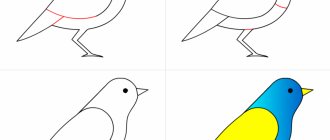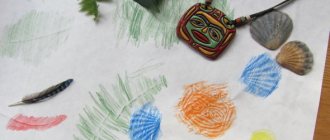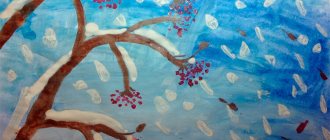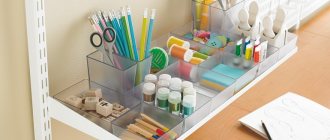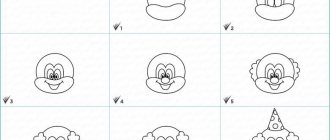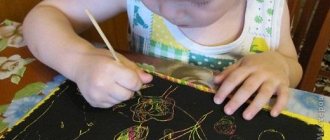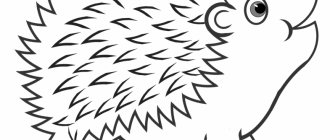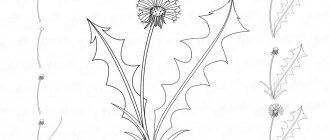Pencil drawing of a house in cells
To draw a house schematically but beautifully, take a pencil, a piece of checkered paper, an eraser, and follow these steps:
- Draw a horizontal straight line along the cells of the sheet.
- On the sides of the resulting line, draw two vertical lines parallel to each other. It is better if they are shorter than the horizontal one.
- We connect the parallels from above with a straight line, draw from it, having first retreated 7 cells upward, finding the middle of the upper horizontal segment, two lines to one point. It turns out to be a roof.
- On the resulting roof we will draw a pipe: draw two straight lines parallel to each other on the side of the roof, connect them at the top, and also add a rectangle on top. Afterwards, you can draw the bricks, marking them straight along the cells of the notebook.
- We add windows and doors to our drawn house the way we want. Here you need to turn on your imagination. You can also add an attic window, shutters, etc.
- To prevent the house from dangling in space, you can add a straight line lawn, a fence, flowers, trees, stones, and a bench. You can also colorize the drawing or leave it black and white.
- The house, drawn in pencil according to the cells, is ready.
This pattern is very simple - even a child can repeat it, but at the same time, everything will look harmonious and beautiful.
Fairytale house
If you don’t want just a sketchy house, then you can always draw a house from a fairy tale. Because there are no rules here, only your imagination. Here are some tips to guide your imagination:
- You can start drawing from the roof, make it slightly curved, asymmetrical.
- Next, we draw the bottom so that it matches the roof and does not go beyond its boundaries.
- Then we draw windows, you can make them of absolutely any shape, doors.
- Add a few details, for example, a lawn, a path, flowers, firewood, whatever you like.
- Decorate with bright colors.
- The house is ready.
Drawing such buildings is perfect for stimulating the imagination and relieving the head of unnecessary thoughts.
Summary of a drawing lesson in the senior group “Builders build houses”
Olga Gorokhova
Summary of a drawing lesson in the senior group “Builders build houses”
TOPIC: "BUILDERS ARE BUILDING HOUSES."
MATERIALS AND EQUIPMENT:
DEMONSTRATION MATERIAL: drawings depicting phased construction, drawing diagrams of a crane, a letter, a house model, human toys, a pointer. HANDOUT: 2 sheets of toned paper (the horizon is located in a horizontal and vertical position of the sheet) - for each child, colored wax crayons, simple pencils.
2. WORK METHODS. explanation.
-Now let’s play with you: I want to build a house: So that there is a window in it, So that the house has a door, So that a pine tree grows in the garden, So that there is a fence around it, So that a dog guards the gate. Let the sun shine. The rain was dripping from the sky and the tulip was blooming in the garden!
5. INDEPENDENT ACTIVITY OF CHILDREN. Individual assistance from the teacher to children who cannot cope with the task. Reminds you not to forget to draw people, etc.
DIAGRAM OF STAGED DRAWING OF A LIFTING CRANE.
READY WORKS FOR CHILDREN.
"Dangerous items at home." Summary of an open lesson on life safety in the senior group Goal: To expand children's understanding of objects that can serve as sources of danger in the house. Objectives: Give presentations.
Summary of a comprehensive lesson in mathematics and drawing for children of the senior group “Sea Voyage” Program content: To consolidate children’s knowledge about the composition of the number 9; ability to name numbers in direct and ordinal counting; measure objects conventionally.
Abstract of the NOD OO "Artistic and Aesthetic Development" in the middle group. Topic: Application “Builders. We are building a house" Synopsis of the NOD OO "Artistic and Aesthetic Development" in the middle group. Topic: Application “Builders. We are building a house." Kushigina's teacher. Summary of GCD for design in the senior group “Builders” Summary of GCD for design in the senior group “Builders” Purpose: to teach children to creatively apply previously acquired constructive skills. Summary of a design lesson in the senior group “Houses on our street” Summary of a design lesson in the senior group. Construction from building materials TOPIC: Houses on our street. The lesson is being held.
Summary of a lesson on life safety in the senior group “Home Alone” Progress of the lesson: Educator: Guess the fairy tale for which the illustration was made. Children: “Cat, rooster, fox” Educator: What is recklessness (what.
Summary of a drawing lesson in the first group of toddlers “Trolley for a hedgehog” Summary of a drawing lesson in the first group of a toddler Topic: “Trolley for a hedgehog” Purpose: Learn to depict rounded shapes, name them.
Summary of a lesson on drawing with palms in the senior group Directly educational area “Artistic creativity. Drawing Integration of OO: “Cognition”, “Communication”, “Music”, “Reading”.
Source
Drawing of a three-dimensional house
In order to add a little reality to the house, it can be made voluminous. To do this you need:
- Prepare drawing materials;
- Let's draw a drawing: start it with a rectangle of any size, whatever is more convenient for you. It's best to start with small sizes first.
- Mentally divide the rectangle into 3 equal parts; you can also use a ruler. And separate one part with a straight vertical line.
- For most of them we find the middle and mark it with a dot. This is how we will outline the roof.
- From the point we draw two straight lines to the side parts of the house. You should get a triangle.
- From the lower right corner of the triangle, draw a horizontal line to the side of the smaller side of the rectangle. That is, we outline the roof of a smaller part of the house.
- Adding windows to most of the house, or living room.
- Let's draw a door.
- You can add a foundation by drawing a narrow rectangle at the bottom of the house.
- Using wavy lines we draw the tiles on the roof. You can also make an edging.
- Add a chimney of the shape you want to the roof.
- We divide the door into two equal parts and draw handles.
- Add a threshold at the bottom of the doors.
- We draw bricks on the foundation.
- We add frames and shutters to the windows.
- You can add a lawn, flowers or a tree.
- All that remains is to color the drawing.
- Our three-dimensional house is ready.
Preparing to Draw
To begin following step-by-step instructions for children, you must first prepare your child for a creative activity:
- In order for the child to be more diligent during this period of time, it is better to initially conduct some kind of active activity before work;
- Careful preparation of the work area will also help to master the master class for beginners. Place the light source on the left, remove everything unnecessary from the table surface so that the child is not distracted.
- All tools also need to be laid out on the surface in advance, this will help you not to look for the desired object while drawing and, again, will not cause you to be distracted. You can involve the child in preparing for the lesson, then this will replace active play;
- Remember that children are just learning everything, so you shouldn’t demand a lot from them right away. While drawing, support your child and answer questions;
- The child must master a simple drawing technique; for this, you should not interfere with his creative process by introducing something or showing him in his drawing. Keep a separate sheet for this, otherwise interest in creativity may fade.
Multi-storey building
In order to draw a multi-story building, you need to calculate the height, number of floors, as well as windows and doors.
All this must be taken into account in order for the design of the house to be harmonious.
The algorithm is as follows:
- First we sketch the facade, drawing a rectangle of the required height.
- We designate the places where windows and doors will be located. You need to make outlines along horizontal lines so that it is even. It's better to use a ruler.
- If the markings of windows and doors suit us, then we draw the windows and doors.
- We add additional details such as pipes, ladders to doors, foundations.
- If you want the house to be brick, then draw the bricks on the facade of the building.
- We color the drawing.
- The multi-storey building is ready.
Note: if you want to draw a house sideways, you can first, after drawing a rectangle, dividing the house vertically into three parts, draw a line, separating one smaller part, thus creating the impression that the house is not facing straight, but sideways.
Hut
In order to draw a hut, you don’t need much time, you just need to take a pencil and follow the instructions:
- Draw a straight horizontal line.
- Next, draw lines a little sideways and up, forming the outline of the hut.
- We mark the middle on the horizontal line, draw a straight line upward with a stroke, mark a point at the top.
- We draw two straight lines through this point, you should get a cross.
- We mark the boundary between the roof and the house.
- We draw windows in the attic, facade.
- Add shutters, draw logs.
- We decorate the hut.
- The drawing is ready.
Materials for work
To know how to draw a house beautifully, you need to decide what will be useful for the job.
The list of materials can be varied:
- Paper or sketchbook;
- Regular pencil and eraser;
- Paints, brushes, sippy cup;
- Markers or colored pencils.
The main thing is to determine what the drawing will be drawn with before work, otherwise time will be wasted searching for the necessary materials.
Drawing an igloo
If you want to add a little exoticism to your drawing of houses, you can draw an ice house - an igloo.
The algorithm is as follows:
- Draw an even semicircle.
- At the bottom we draw an oval.
- Erase the top part with an eraser.
- We draw in a semicircle, stepping back approximately a centimeter from each.
- We mark bricks on each semicircle.
- We decorate the cubes with suitable colors.
- The ice igloo is ready.
Ice house is very easy to draw and you can teach it to your child.
House with watercolor paints
You can also paint a house with paints, it will turn out very non-standard and interesting.
To get the picture right, take brushes of different sizes and watercolors. Start drawing:
- To begin, you will need a small brush to outline the outline.
- Draw a cube, it's okay if it's not completely straight.
- Draw a pyramid above it. You can choose other shapes for the roof.
- Take a smaller brush and add windows and a door.
- Let the paint dry.
- With the same brush, mark small details such as: handles, shutters, tiles, bricks.
- Let the paint dry again.
- Add foundation using a thick brush.
- While the paint dries, paint the roof.
- After the part where the foundation is drawn dries, paint the facade.
- You can add earth, flowers, trees, paths, stones, sky also using paint and brushes.
- The house is ready.
This technique is somewhat more complicated than drawing with a pencil, but more interesting.
House using sketching technique
This technique seems complicated, but only at first glance; besides, if you hone the skill, you will get very beautiful, unusual drawings.
For the sketch you will need:
- leaf watercolor;
- pencil;
- eraser;
- brush;
- watercolor;
Having prepared everything you need, move on to the instructions:
- Divide the sheet into four more or less even parts.
- Draw a rectangle.
- Mark the places where the roof will be located. This part should take up half of the top of the rectangle. Draw a horizontal line.
- On the left side we depict a visor. Let's make it triangular.
- Erase the auxiliary lines in this part.
- From the visor we draw two parallel straight lines.
- Next we will outline the windows and doors. You can mark the balcony.
- Below the window we mark the door.
- We draw the cornice and window shutters.
- We outline the drawing and erase all the auxiliary lines with an eraser.
- We add greenery to the house: bushes, trees, grass, flowers and so on.
- We draw windows, doors, and tiles with a thick pencil.
- We schematically designate the brick.
- We begin to paint the sketch with watercolors. You can go beyond the contour.
- Try to make shadows in places where there should be shadow. But not necessarily.
- The drawing is ready.
The sketching technique is fast and beautiful. In addition, you don’t need to worry about drawing and perspective.
Now you know how to draw at home using various techniques, you can choose the best one for yourself or your child. In addition, drawing develops the imagination very well.
The main thing is not to prohibit adding various elements and not to demand that the child unquestioningly adhere to the drawing algorithm. Among other things, drawing is also good for developing perseverance.
Lesson notes. Drawing with colored pencils on the topic “Construction of a new house”
Detsky sad.Ru >> Electronic library >> Family and children >> Children's creativity >> Sakulina N. P. and Komarova T. S. “Art activities in kindergarten” (Manual for teachers).
M., “Enlightenment”, 1973 OCR Detskiysad.Ru Abbreviated. Program content.
Teach children to convey impressions of the surrounding life in drawings, to correctly place images on a sheet of paper (houses, people, equipment), maintaining their proportions and relative size. Strengthen the ability to hold a pencil correctly, draw lines smoothly, and use learned methods of drawing rectangular shapes. Practice ease and freedom of movement when drawing with a pencil. Learn to draw the outline of objects with one graphite pencil, without pressing it hard, without drawing details of the image with it; learn how to carefully paint over drawings. Methodology of conducting the lesson. Remember with the children that during the walk they saw how a house was built, how a crane worked. To say that in our country many houses are being built so that everyone can live well, that the builders make the walls smooth, straight, so that the house is strong, beautiful, so that it serves people for a long time and it is pleasant to live in it; The windows in the houses are also arranged in even rows. Invite children to remember how lines are drawn from top to bottom and from left to right. Ask why they need to draw this way (what rule do they know). Determine which part of the house you need to start with, what to paint next. Determine where the house will be and where the crane will be. Call one child to show how he will draw, ask the rest to see if he uses the correct method of drawing walls and window openings. Then you need to invite all the children to take a pencil, show how they hold it, and start drawing. “Start drawing along the bottom edge of the paper, but leave a strip of land at the bottom of the sheet,” the teacher clarifies. “You can draw a house under construction, a stole, or whatever you want.” During the drawing process, it is necessary to monitor the location of the drawing and the use of the previously shown pencil drawing techniques. Those who act incorrectly should be reminded how to draw. Make sure that children hold the pencil correctly and freely when drawing lines and painting pictures, and adjust their hand if necessary. At the end of the lesson, you should examine the drawings and pay attention to the straightness and difference in the structure of the walls. Invite some children to choose the most interesting drawings, and also tell them what building they themselves drew, where it is being built, and whether it will be ready soon. Preparing for the lesson. First, invite the children to make an appliqué on the tama “House in the Evening.” Indicate that the walls of the house are smooth, straight, and the windows are located in even rows. Take your children to a house construction site, see how the crane works, what cars drive up to the construction site and what is being delivered. Talk about the fact that there is a lot of construction going on in our country, that many new houses are being built in the city (village) where the kindergarten is located. Prepare for the lesson paper the size of a writing sheet, pencils (at least 12 colors), a simple graphite pencil. Note. Since children have the opportunity to often see construction, it is recommended that this topic be offered repeatedly in both the senior and preparatory groups, for example, the construction of a kindergarten, a new school, a cinema, a club, a poultry farm, etc. (depending on what the children saw during walks and excursions). continuation …

